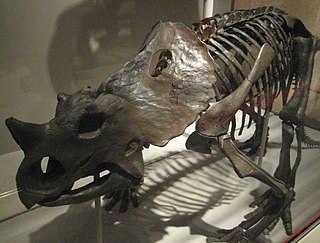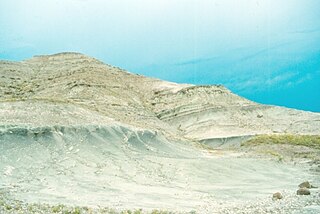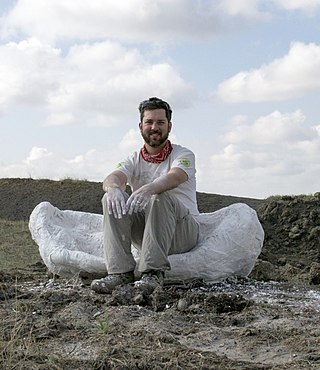
Hadrosaurids, or duck-billed dinosaurs, are members of the ornithischian family Hadrosauridae. This group is known as the duck-billed dinosaurs for the flat duck-bill appearance of the bones in their snouts. The ornithopod family, which includes genera such as Edmontosaurus and Parasaurolophus, was a common group of herbivores during the Late Cretaceous Period. Hadrosaurids are descendants of the Late Jurassic/Early Cretaceous iguanodontian dinosaurs and had a similar body layout. Hadrosaurs were among the most dominant herbivores during the Late Cretaceous in Asia and North America, and during the close of the Cretaceous several lineages dispersed into Europe, Africa, and South America.

Brachylophosaurus was a mid-sized member of the hadrosaurid family of dinosaurs. It is known from several skeletons and bonebed material from the Judith River Formation of Montana, the Wahweap Formation of Utah and the Oldman Formation of Alberta, living about 81-76.7 million years ago.

Hypacrosaurus was a genus of duckbill dinosaur similar in appearance to Corythosaurus. Like Corythosaurus, it had a tall, hollow rounded crest, although not as large and straight. It is known from the remains of two species that spanned 75 to 67 million years ago, in the Late Cretaceous of Alberta, Canada, and Montana, United States, and is the latest hollow-crested duckbill known from good remains in North America. It was an obscure genus until the discovery in the 1990s of nests, eggs, and hatchlings belonging to H. stebingeri.

Gryposaurus was a genus of duckbilled dinosaur that lived about 80 to 75 million years ago, in the Late Cretaceous of North America. Named species of Gryposaurus are known from the Dinosaur Park Formation in Alberta, Canada, and two formations in the United States: the Lower Two Medicine Formation in Montana and the Kaiparowits Formation of Utah. A possible additional species from the Javelina Formation in Texas may extend the temporal range of the genus to 66 million years ago.

Brachyceratops is a dubious genus of ceratopsian dinosaur known only from partial juvenile specimens dating to the late Cretaceous Period of Montana, United States.

The Two Medicine Formation is a geological formation, or rock body, in northwestern Montana and southern Alberta that was deposited between 83.5 ± 0.7 Ma and 70.6 ± 3.4 Ma, during Campanian time. It crops out to the east of the Rocky Mountain Overthrust Belt, and the western portion of this formation is folded and faulted while the eastern part, which thins out into the Sweetgrass Arch, is mostly undeformed plains. Below the formation are the nearshore deposits of the Virgelle Sandstone, and above it is the marine Bearpaw Shale. Throughout the Campanian, the Two Medicine Formation was deposited between the western shoreline of the Late Cretaceous Interior Seaway and the eastward advancing margin of the Cordilleran Overthrust Belt. The Two Medicine Formation is mostly sandstone, deposited by rivers and deltas.

Prosaurolophus is a genus of hadrosaurid dinosaur from the Late Cretaceous of North America. It is known from the remains of at least 25 individuals belonging to two species, including skulls and skeletons, but it remains obscure. Its fossils have been found in the late Campanian-age Upper Cretaceous Dinosaur Park Formation in Alberta, and the roughly contemporaneous Two Medicine Formation in Montana, dating to around 75.5-74.0 million years ago. Its most recognizable feature is a small solid crest formed by the nasal bones, sticking up in front of the eyes.

The Judith River Formation is a fossil-bearing geologic formation in Montana, and is part of the Judith River Group. It dates to the Late Cretaceous, between 79 and 75.3 million years ago, corresponding to the "Judithian" land vertebrate age. It was laid down during the same time period as portions of the Two Medicine Formation of Montana and the Oldman Formation of Alberta. It is an historically important formation, explored by early American paleontologists such as Edward Drinker Cope, who named several dinosaurs from scrappy remains found here on his 1876 expedition. Modern work has found nearly complete skeletons of the hadrosaurid Brachylophosaurus.

Wulagasaurus is a genus of saurolophine hadrosaurid dinosaur from the Late Cretaceous of Heilongjiang, China.

The Aguja Formation is a geological formation in North America, exposed in Texas, United States and Chihuahua and Coahuila in Mexico, whose strata date back to the Late Cretaceous. Dinosaur remains are among the fossils that have been recovered from the formation. Fossil palms have also been unearthed here.
The Mooreville Chalk is a geological formation in North America, within the U.S. states of Alabama and Mississippi, which were part of the subcontinent of Appalachia. The strata date back to the early Santonian to the early Campanian stage of the Late Cretaceous. The chalk was formed by pelagic sediments deposited along the eastern edge of the Mississippi embayment. It is a unit of the Selma Group and consists of the upper Arcola Limestone Member and an unnamed lower member. Dinosaur, mosasaur, and primitive bird remains are among the fossils that have been recovered from the Mooreville Chalk Formation.
Continuoolithus is an oogenus of dinosaur egg found in the late Cretaceous of North America. It is most commonly known from the late Campanian of Alberta and Montana, but specimens have also been found dating to the older Santonian and the younger Maastrichtian. It was laid by an unknown type of theropod. These small eggs are similar to the eggs of oviraptorid dinosaurs, but have a distinctive type of ornamentation.

Acristavus is a genus of saurolophine dinosaur. Fossils have been found from the Campanian Two Medicine Formation in Montana and Wahweap Formation in Utah, United States. The type species A. gagslarsoni was named in 2011. Unlike nearly all hadrosaurids except Edmontosaurus, Acristavus lacked ornamentation on its skull. The discovery of Acristavus is paleontologically significant because it supports the position that the ancestor of all hadrosaurids did not possess cranial ornamentation, and that ornamentation was an adaptation that later arose interdependently in the subfamilies Saurolophinae and Lambeosaurinae. It is closely related to Brachylophosaurus and Maiasaura, and was assigned to a new clade called Brachylophosaurini.

Brachylophosaurini is a tribe of saurolophine hadrosaurs with known material being from N. America and potentially Asia. It contains at least four taxa; Acristavus, Brachylophosaurus, Maiasaura, and Probrachylophosaurus. A hadrosaur from the Amur river, Wulagasaurus, might be a member of this tribe, but this is disputed. The group was defined by Terry A. Gates and colleagues in 2011.

Kritosaurini is a tribe of saurolophine hadrosaurid dinosaurs from the Late Cretaceous.

Oohkotokia is a genus of ankylosaurid dinosaur within the subfamily Ankylosaurinae. It is known from the upper levels of the Two Medicine Formation of Montana, United States. The discovery of Oohkotokia supports that Ankylosaurine dinosaurs existed and flourished continuously in Montana and/or Alberta throughout the late Campanian and early Maastrichtian stages in the Late Cretaceous period. It was a large, heavily built, quadrupedal, herbivore, that could grow up to 5 metres (16 ft) long and weigh up to 2 metric tons.

This timeline of hadrosaur research is a chronological listing of events in the history of paleontology focused on the hadrosauroids, a group of herbivorous ornithopod dinosaurs popularly known as the duck-billed dinosaurs. Scientific research on hadrosaurs began in the 1850s, when Joseph Leidy described the genera Thespesius and Trachodon based on scrappy fossils discovered in the western United States. Just two years later he published a description of the much better-preserved remains of an animal from New Jersey that he named Hadrosaurus.

Probrachylophosaurus bergei is a species of large herbivorous brachylophosaurin hadrosaurid dinosaur known from the Late Cretaceous Campanian Judith River Formation, of Montana and the Foremost Formation of Alberta.

David Christopher Evans is a Canadian palaeontologist and evolutionary biologist who specializes in the evolution and paleobiology of Cretaceous dinosaurs in western North America. He received his B.Sc. from the University of British Columbia and his Ph.D. from the University of Toronto. He is a fellow of the Royal Canadian Geographical Society (RCGS) and a member of the Royal Society of Canada and currently serves as the Senior Curator and Temerty Chair of Vertebrate Paleontology at the Royal Ontario Museum in Toronto, Canada. He is also a faculty member in the Department of Ecology & Evolutionary Biology at the University of Toronto. Evans is particularly renowned for his work on the paleobiology of hadrosaur ("duck-billed") dinosaurs and has conducted international research on a wide variety of paleontological topics.

































